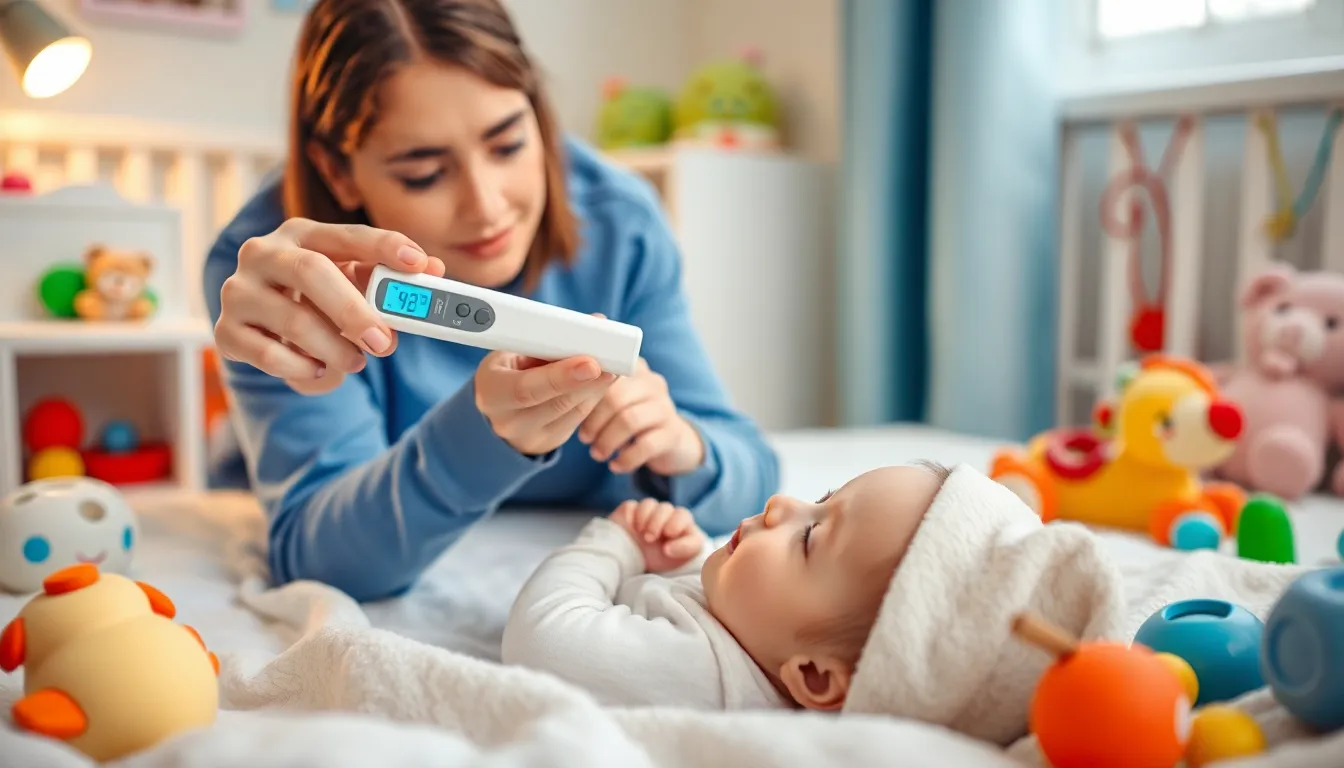Physical Address
304 North Cardinal St.
Dorchester Center, MA 02124

When it comes to babies and fevers, parents often feel like they’re navigating a minefield. One minute, everything’s fine, and the next, they’re Googling symptoms like it’s an Olympic sport. So, is 99.9°F a fever for a baby? Spoiler alert: it might not be the cause for alarm you think it is.
In the world of tiny humans, body temperature can be as unpredictable as a toddler’s mood. While adults might break a sweat at the thought of a fever, babies have their own set of rules. Understanding what constitutes a fever is crucial for any parent who’s ever felt their heart race at the sight of a thermometer reading. Let’s dive in and separate the myths from the facts about baby fevers, starting with that all-important 99.9°F mark.
Body temperature varies in babies, making it crucial to recognize what constitutes a fever. A temperature of 99.9°F prompts many parents to wonder if their baby has a fever. Typically, normal body temperature for babies ranges from 97°F to 100.4°F. Therefore, a reading of 99.9°F is often not viewed as a fever but falls within the acceptable range.
When assessing a baby’s temperature, parents should consider how the baby behaves in addition to the number. A baby may appear well despite a slightly elevated temperature, so observation of activity levels, eating patterns, and overall demeanor matters. Sometimes a baby with a mild increase in temperature remains active and alert.
Taking an accurate measurement can be challenging, as methods vary. Rectal temperatures provide the most reliable readings, while oral, axillary (underarm), and tympanic (ear) methods can yield different results. Understanding the method used is vital in determining if a 99.9°F reading indicates a fever.
Parental intuition plays an essential role in evaluating a baby’s health. If a 99.9°F temperature occurs along with signs of discomfort—irritability, lethargy, or decreased appetite—medical consultation is advisable.
The context of fever also varies based on a baby’s age and health history. For infants younger than three months, a rectal temperature of 100.4°F or higher warrants immediate medical attention.
Understanding fever thresholds and monitoring accompanying symptoms helps parents navigate this aspect of infant care effectively.

Monitoring a baby’s temperature becomes essential, especially when concerns about fever arise. Parents should check their baby’s temperature when symptoms like irritability, lethargy, or changes in appetite occur.
Rectal temperatures provide the most accurate readings for infants. Digital thermometers are easy to use and offer quick results. Using an ear thermometer is effective, but accuracy can vary based on technique. Underarm thermometers yield lower readings and may not always reflect true body temperature. Taking temperature at different times throughout the day can also reveal a pattern, especially during illness.
Normal body temperature in babies ranges from 97°F to 100.4°F. A reading of 99.9°F often falls within this range. Babies may experience variations due to factors like activity level and time of day. Parents should note that temperatures can be slightly higher during teething or after a bath. Being aware of these fluctuations aids in better understanding a baby’s baseline temperature.
A temperature of 99.9°F is often not classified as a fever for babies. Normal body temperatures usually range from 97°F to 100.4°F, so 99.9°F falls within that acceptable spectrum. Parents should monitor their babies’ reactions and behaviors alongside temperature readings to assess overall health.
Age plays a significant role in determining whether 99.9°F is concerning. For infants younger than three months, a rectal temperature of 100.4°F or higher warrants immediate medical attention. When it concerns older infants and toddlers, slightly elevated temperatures often indicate mild illness rather than severe conditions. Parents should remain vigilant, as babies in this age group can display varying responses to temperatures. Recognizing the differences based on age can help parents make informed decisions regarding care and when to seek medical advice.
Observing additional symptoms alongside a 99.9°F temperature is essential for evaluating a baby’s health. Signs such as irritability, lethargy, changes in appetite, or difficulty sleeping may indicate that medical attention is necessary. If a baby shows signs of dehydration, such as dry mouth or fewer wet diapers, this could suggest a more serious underlying issue. Coughing or difficulty breathing also warrants close attention. By monitoring these symptoms closely, parents can better determine if their baby requires further evaluation or possible treatment.
Managing a fever in babies requires careful observation and appropriate actions. Parents should be proactive in their approach, using safe methods to provide comfort.
Nursing a baby with a mild fever can often be done at home. Offering plenty of fluids helps prevent dehydration, which is critical for maintaining health. Dressing the baby in lightweight clothing promotes comfort and prevents overheating. Luke-warm baths soothe the skin and may lower the temperature a bit. Some parents find comfort in using infant acetaminophen or ibuprofen when necessary, but it’s essential to follow dosage guidelines based on the baby’s weight. Consulting with a pediatrician before administering any medication ensures safety and effectiveness.
Recognizing concerning signs in a baby with a fever is vital. Parents should reach out for medical help if the baby is under three months old with a rectal temperature of 100.4°F or higher. Breathing difficulties or persistent crying after comforting efforts also require immediate attention. Notably, any signs of dehydration, such as a dry mouth or fewer wet diapers, call for professional evaluation. If the baby’s irritability escalates or energy levels drop significantly, seeking guidance from a healthcare provider is advisable. Regularly monitoring symptoms helps ensure prompt action when needed.
A temperature of 99.9°F in a baby is generally not classified as a fever. It falls within the normal range and often doesn’t indicate a serious health issue. Parents should focus on their baby’s overall behavior and any accompanying symptoms to gauge their well-being.
Being attentive to changes in appetite or energy levels can provide valuable insights. While slight elevations in temperature can be common, especially during mild illnesses, it’s crucial to monitor for signs that may require medical attention.
Staying informed and observing the baby closely allows parents to make confident decisions regarding their child’s health.